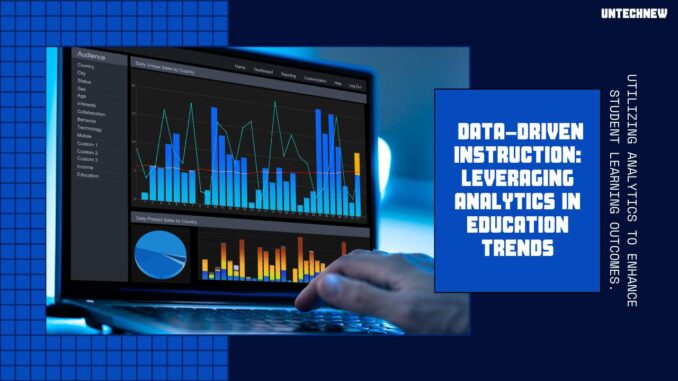
Introduction:
In today’s digital age, data-driven decision-making has become increasingly prevalent across various industries, including education. Data-driven instruction involves the use of student data and analytics to inform teaching practices, curriculum development, and educational interventions. By leveraging data analytics, educators can gain valuable insights into student learning patterns, identify areas for improvement, and tailor instruction to meet individual needs effectively. In this article, we’ll explore the concept of data-driven instruction, its role in education trends, benefits, challenges, and best practices for implementation.
Understanding Data-Driven Instruction
Data-driven instruction involves collecting, analyzing, and interpreting student data to inform instructional decisions and improve learning outcomes. This data can include a wide range of information, such as academic performance, assessment scores, attendance records, behavior data, and demographic information. By systematically analyzing this data, educators can identify trends, patterns, and areas of concern, allowing them to make informed decisions about curriculum design, teaching strategies, and student support initiatives.
The Role of Analytics in Education Trends
Data-driven instruction is a significant component of broader education trends related to personalized learning, competency-based education, and the integration of technology in the classroom. Analytics tools and technologies enable educators to:
- Personalize Learning: By analyzing student data, educators can identify individual learning needs, preferences, and strengths, allowing for personalized learning experiences tailored to each student’s unique requirements.
- Monitor Progress: Data analytics enable educators to monitor student progress in real-time, track learning outcomes, and identify areas where students may be struggling or excelling.
- Inform Instruction: By analyzing assessment data and learning analytics, educators can make data-informed decisions about instructional strategies, curriculum adjustments, and intervention strategies to support student learning.
- Evaluate Effectiveness: Data-driven instruction allows educators to evaluate the effectiveness of teaching practices, interventions, and educational programs, enabling continuous improvement and refinement based on evidence-based practices.
- Predictive Analytics: Predictive analytics tools can forecast student outcomes, identify at-risk students, and proactively intervene to prevent academic challenges or disengagement.
Benefits of Data-Driven Instruction
Data-driven instruction offers a range of benefits for students, educators, and educational institutions:
- Improved Learning Outcomes: By tailoring instruction to individual student needs, data-driven instruction can lead to improved learning outcomes, increased academic achievement, and higher student engagement.
- Personalized Learning Experiences: Data analytics enable educators to create personalized learning experiences that meet the diverse needs and preferences of students, promoting deeper understanding and retention of course material.
- Early Intervention: By identifying at-risk students early and intervening with targeted support and interventions, data-driven instruction can prevent academic struggles and improve student success rates.
- Efficient Resource Allocation: Data analytics enable educators to allocate resources, such as instructional materials, technology tools, and support services, more efficiently based on identified needs and priorities.
- Evidence-Based Decision-Making: Data-driven instruction facilitates evidence-based decision-making in education, enabling educators to base instructional decisions on empirical evidence rather than intuition or anecdotal observations.
Challenges of Implementing Data-Driven Instruction
Despite its potential benefits, implementing data-driven instruction poses several challenges:
- Data Quality and Accessibility: Ensuring the quality, accuracy, and accessibility of student data can be challenging, particularly in systems with disparate data sources and limited interoperability.
- Privacy and Security Concerns: Collecting and storing student data raises privacy and security concerns, requiring robust data protection measures and compliance with relevant regulations such as the Family Educational Rights and Privacy Act (FERPA).
- Teacher Training and Support: Educators may require training and support to effectively interpret and utilize data analytics tools and technologies in their teaching practice.
- Resistance to Change: Resistance to change among educators, administrators, and stakeholders can hinder the adoption and implementation of data-driven instruction initiatives.
- Ethical Considerations: Data-driven instruction raises ethical considerations related to equity, bias, and fairness, particularly in decisions related to student assessment, placement, and support.
Best Practices for Implementing Data-Driven Instruction
To effectively implement data-driven instruction, educators and educational institutions can follow these best practices:
- Establish Clear Goals: Define clear objectives and goals for data-driven instruction initiatives, aligning them with broader educational priorities and objectives.
- Use Reliable Data Sources: Ensure the accuracy, reliability, and integrity of student data by using standardized assessment tools, reliable data sources, and secure data management practices.
- Provide Training and Support: Offer professional development opportunities, training workshops, and ongoing support to help educators develop the knowledge and skills needed to interpret and utilize data effectively.
- Promote Data Literacy: Foster a culture of data literacy among educators, administrators, and stakeholders, providing resources, tools, and training to enhance their understanding of data analytics and its applications in education.
- Collaborate and Share Best Practices: Encourage collaboration and knowledge-sharing among educators and educational institutions to exchange best practices, lessons learned, and successful strategies for implementing data-driven instruction.
Conclusion
Data-driven instruction is transforming education by leveraging the power of data analytics to inform teaching practices, personalize learning experiences, and improve student outcomes. By systematically analyzing student data, educators can gain valuable insights into student learning needs, monitor progress, and make informed decisions about curriculum design, instructional strategies, and student support initiatives. While implementing data-driven instruction poses challenges related to data quality, privacy, and resistance to change, following best practices and fostering a culture of data literacy can help educators harness the potential of data analytics to enhance teaching and learning in the digital age. As data-driven instruction continues to evolve, it holds the promise of creating more effective, equitable, and student-centered learning environments that prepare students for success in an increasingly data-driven world.

Leave a Reply